Physical Address
304 North Cardinal St.
Dorchester Center, MA 02124
The incidence of hand injuries increases 20-fold after age 10, with sports being the most common mechanism of injury. High impact sports such as football tend to produce injuries from single traumatic events, whereas repetitive overuse injuries are more common in sports such as gymnastics, golf, and tennis. We have focused on conditions and treatment considerations unique to the adolescent population.
One of the most challenging conditions is pain of unclear etiology. To minimize frustration in patients, parents, coaches, and physicians, it is important to have a clear treatment algorithm for these situations. Patients with neurologic-type symptoms in a nonanatomic distribution should be examined for neural tension signs more proximally, and nerve gliding exercises may be the key to achieving return to sport. Nonspecific wrist pain is common due to ligamentous laxity and muscular immaturity. A neuromuscular training program emphasizing resistive strengthening relieves symptoms in most patients. A baseline therapy evaluation for grip and pinch strength is followed by a 6-week exercise program while concomitantly protecting the wrist joint and modifying activities. Patients who fail to improve their strength should continue exercises. If their pain is ongoing despite improved strength, MRI evaluation is undertaken. As always, it is important to validate symptoms and tailor treatment to patient goals.
Fractures account for two-thirds of hand injuries in the under 16 age group. Skeletally immature patients are vulnerable to unique patterns of injuries, as the weak points in their anatomy are the growth plate and subcapital region of the phalanges. The Seymour fracture is an open fracture of the distal phalanx through the physis that can present similar to a mallet injury, with about half occurring during sports. Subcapital fractures of the phalangeal neck appear deceptively benign and therefore often have a delayed presentation. Phalangeal base fractures are most commonly seen in the small finger proximal phalanx, 22 of 34 fingers in one series, where they carry the eponym “extra octave fracture” due to ulnar dorsal angulation giving the appearance of the small finger trying to reach further on piano keys. Metacarpal fractures can occur in any age group, but are most common in 10- to 19-year-olds involved in basketball, football, or bicycling.
Seymour fractures often occur with hyperflexion of the distal interphalangeal (DIP) joint similar to a mallet finger, though many describe a “crushing” component to their mechanism. Bleeding at the time of injury distinguishes an open fracture from a closed nailbed or distal tuft injury. Prior antibiotic treatment should be determined.
Subcapital fractures also occur after crush injuries in sports, with immediate pain and swelling. Bruising may be minimal in this relatively avascular region. Motion, specifically flexion, is limited. With restricted motion, patients can be relatively painless, often leading to delayed presentation.
Phalangeal base fractures occur most commonly with a dorsal ulnar pull on the digit, resulting in immediate pain and deformity. Reduction may or may not have been attempted on the field. Boxer's fractures occur after direct impact of the dorsal 5th metacarpal head. True boxing is a rare cause, as punching should axially load the 2nd and 3rd metacarpal heads. Patients will notice decreased prominence of the knuckle. If patients complain of repetitive snapping or popping, one should suspect a “boxer's knuckle,” or sagittal band rupture allowing subluxation of the extensor tendon.
Swelling, integrity of the nail and nailfold, ecchymosis, and resting position should be noted. A Seymour fracture may have been splinted in extension with the proximal nail resting superficial to the eponychial fold. This can give the subtle appearance of a longer nail. There will be an extension lag at the DIP joint. Dried blood should be noted, as well as any signs of infection in late presenting cases. As with any injury, concomitant injuries should be looked for, with the most common being additional finger fractures.
Phalangeal neck fractures will present with a swollen proximal interphalangeal (PIP) or DIP joint, depending on whether the fracture is in the proximal or middle phalanx, respectively. Tenderness to palpation is important, as this indicates the fracture is mobile and more amenable to percutaneous reduction. Flexion is limited due to pain and angulation. Coronal plane angulation is examined in extension, while malrotation is best assessed for with flexed digits to demonstrate under- or overlapping. In patients unable to flex due to pain, passively extending the wrist will utilize the tenodesis effect to flex the digits ( Fig. 135.1 ). This can be done while palpating the scaphoid tubercle, as all digit tips should point toward the tubercle in flexion.
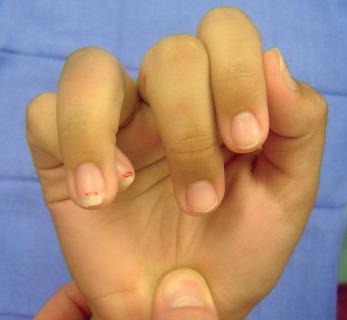
Phalangeal base fractures will have obvious hyperextension and ulnar angulation around the metacarpophalangeal (MCP) joint. Making a full fist may be still possible due to composite flexion. Boxer's fractures demonstrate a depressed knuckle. Rarely the apex dorsal angulation will cause skin tenting, threatening open injury due to thin skin and tendon covering. Malrotation is uncommon but crucial to assess for. Contralateral comparison is important, as there are varying degrees of baseline digit angulation.
Anteroposterior (AP), lateral, and oblique radiographs of the digit should be obtained for all finger injuries, as there will be less digital overlap on the lateral and oblique views compared with hand radiographs, which are more appropriate for metacarpal fractures. Resting position and soft tissue swelling are important to note in addition to the fracture. Seymour fractures will show flexion through the distal phalangeal physis ( Fig. 135.2 ). If held in extension, however, the injury can be subtle with widening of the physis alone.
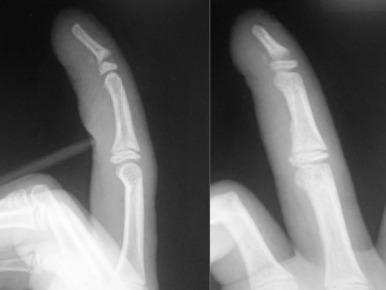
Subcapital fractures are often missed on the AP view, as hyperextension causes bony overlap. If not familiar with skeletally immature radiographs, the interpreter may mistake the transverse fracture line for a physis. Physes should be proximal in the phalanges instead of the distal neck region. One should check for intra-articular extension, as intercondylar fractures tend to be more unstable and will often flex and shorten, even when initially nondisplaced. The lateral view will typically demonstrate extension of the distal fragment. Malrotation can be a subtle “double bump” of the condyles of the phalangeal head on a true lateral where adjacent condyles are collinear ( Fig. 135.3A ).
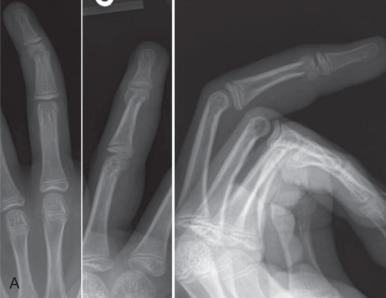
Phalangeal base and metacarpal fractures are best assessed on oblique views of the finger and hand, respectively, as other views minimize apparent angulation. These fractures likely involve the physis in a Salter Harris II pattern. Angulation is typically dorso-ulnar in the small finger proximal phalanx ( Fig. 135.4A ) and palmar-radial in the metacarpal neck.
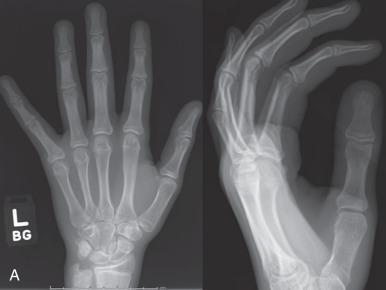
Hand fractures will often present late, as athletes are able to continue playing, and fear of restrictions may lead patients to downplay their injury. Radiographs should be obtained with any history of trauma and immediate swelling. Juxta-articular soft tissue injuries and unstable finger fractures have acute presentations too similar to distinguish accurately by clinical exam alone. Examination under digital block is poorly tolerated in the adolescent patient.
Both Seymour and subcapital fractures are inherently unstable; therefore operative stabilization is indicated in all but absolutely nondisplaced fractures. Phalangeal base and metacarpal neck fractures are close to both the physis and the 5th MCP joint with multiplanar motion. This allows for remodeling as well as better tolerance of angulation.
Nailbed injuries with underlying closed distal tuft fractures are stabilized by the nail itself and managed nonoperatively. Due to instability, Seymour fractures are operative injuries involving a combination of antibiotics, nailbed repair, fracture reduction, and stabilization. One study recommended oral antibiotics be given immediately and continued 4 days postoperatively in any case treated over 6 hours after presentation. Nailbed repair was traditionally employed with a fine absorbable suture such as 6.0 chromic; however, a randomized control trial (RCT) demonstrated faster repair time and similar results using 2-octylcyanoacrylate (Dermabond; Ethicon Inc, Somerville, NJ). Fracture stabilization produces a more favorable environment for soft tissue healing and theoretically minimizes infection in Seymour fractures. Splinting alone risks late displacement; therefore pinning is often employed.
Nonoperative management is rarely indicated for subcapital fractures. Nondisplaced fractures can be immobilized in extension with weekly radiographs for the first 3 weeks to ensure maintained alignment. While splinting is not ideal in this often-noncompliant age group, it allows for better lateral radiographs. Digital overlap will obscure a good lateral if casted. Displaced fractures are ideally close reduced and percutaneously pinned (see Fig. 135.3B ). Phalangeal neck fractures over 3 weeks from injury may be difficult to reduce closed. Percutaneous osteoclasis can be attempted; however, open reduction should be undertaken with caution, as the tenuous blood supply of the mostly articular distal fragment through the collaterals can be disrupted. Internal fixation with headless screws can be considered to allow early postoperative motion, as the PIP joint is prone to stiffness.
Phalangeal base fractures are mostly amenable to nonoperative management. Within the first 2 weeks, fracture site mobility should allow closed reduction with ligamentotaxis with or without digital nerve block (see Fig. 135.4B ). The broad fracture surface across the physis and metaphysis lends it to be relatively stable. Acutely irreducible fracture has been reported with entrapped tendon and is a rare indication for open reduction. If operative reduction is undertaken, Kirschner wire (K-wire) stabilization is performed by entering the head of the proximal phalanx and driving the pin across the flexed MCP joint, leaving the PIP free. In late presenting injuries that cannot be close reduced, it is prudent to allow healing and consider later corrective osteotomy. This allows remodeling and minimizes the risk of iatrogenic damage to the physis.
Boxer's fractures, though relatively unstable, are also amenable to nonoperative treatment in most cases ( Fig. 135.5 ). If reduction is performed, the ring and small fingers are traditionally casted in the intrinsic plus position (MCP flexion and PIP/DIP extension) for 4 weeks. Casting in MCP joint extension up to the PIP joints has been shown to be well tolerated with better range of motion (ROM) and grip strength without any difference in fracture angulation compared with traditional intrinsic plus positioning in a RCT. Operative indications include open injuries, multiple fractures, malrotation, shortening causing pseudoclawing, and strong patient/parent preference. Multiple percutaneous pin configuration options have been described. Internal fixation options exist, such as a condylar blade plate, but involve crossing the physis in adolescents and may become stress risers for additional fractures with subsequent trauma.
Seymour fractures, when possible, have antibiotics and tetanus prophylaxis administered acutely. Under finger tourniquet control, the nail plate is removed, as it blocks reduction and cleansing of the open fracture. The Betadine-cleansed nail or a piece of Xeroform dressing is placed under the eponychial fold to splint it open, and the fracture is reduced with a combination of extension and volar directed translational pressure. It is important to hold this reduction, as the fracture is unstable, and multiple reductions can damage the physis. A K-wire, usually 0.045 in adolescents, is inserted into the digit tip and driven across the physis and distal interphalangeal (DIP) joint to rest in the middle phalanx. The K-wire is cut and left buried. Dermabond is used to repair the nailbed, secure the nail plate, and cover the pin site, except in cases with concern for infection, as drainage should be allowed. I do not routinely prescribe antibiotics postoperatively, and instead reserve it for cases that appear contaminated.
Displaced, angulated, or rotated proximal phalangeal neck fractures are managed with closed reduction and intrafocal pinning when possible. I utilize a technique of proximal interphalangeal flexion and rotation to obtain reduction, followed by K-wire insertion through the head of the proximal phalanx. The wire is driven out through the base of the proximal phalanx, holding the MCP joint in full flexion and pulled proximally until it rests just subchondral in the proximal phalanx head. The PIP joint is extended to allow the wire to be driven into the middle phalanx for additional fixation. One 0.045 K-wire will typically hold the digit in the intrinsic plus position and incur sufficient stability; however, this can be supplemented with an additional wire for rotational control as needed. Pins are left percutaneous, and a protective overlying cast is placed.
Middle phalangeal neck fractures are managed similarly, with the difference that slight angulation and flexion deficits are better tolerated near the DIP joint. For subacute fractures that are still tender, I will perform dorsolateral percutaneous osteoclasis with a K-wire. I do not risk avascular necrosis (AVN) with open reduction. Some sagittal remodeling may occur through the growth plate under the cartilage cap. For limitation of flexion alone, volar bone spike can be removed to clear the subcondylar fossa and tends to improve motion. For malrotation or angulation, corrective osteotomy can be performed in a safer region more proximally in the shaft.
Phalangeal base fractures are best managed with closed reduction under digital nerve block. Entry into the ulnar aspect of the palmodigital crease allows lidocaine infiltration proximally about both radial and ulnar digital nerves, as well as dorsally for a complete block. This is better tolerated than a needlestick into the sensitive palm. For the small finger, a fulcrum such as a thin pen is placed into the 4th webspace. The small finger is brought over this fulcrum into hyperflexion and maximum radial deviation. A palpable reduction is typically appreciated. Postreduction radiographs are obtained, though clinical appearance and ROM determine acceptable alignment.
Boxer's fractures are managed nonoperatively with the exceptions noted previously. Closed reduction is with the Jahss maneuver, flexing the MCP joint and extending the PIP joint to push the metacarpal head dorsal while relaxing the intrinsic muscles. When no reduction is desired, my preference is for buddy taping as soon as comfort allows. Some patients will request higher degrees of immobilization, in which case various prefabricated boxer's fracture braces are commercially available and stocked in the clinic. Athletes can return to sports as soon as pain and mobility allow, often within 2 weeks once the fracture has stabilized with provisional callus. Operative management is with closed or percutaneous reduction when possible. With a Kapandji technique, a K-wire inserted into the fracture site dorsolaterally can lever on the intramedullary canal of distal fragment as needed. Stabilization is performed with 2 K-wires, typically 0.045 or 0.054, inserted into the dorsal metacarpal head from ulnar and radial and driven to the base of the metacarpal, left percutaneous.
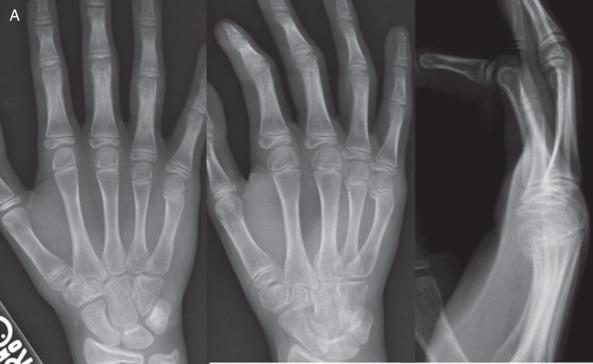
Patients with K-wires are splinted or casted for protection of the fracture and hardware. Pins left percutaneously out of the skin are removed in the clinic around 4 weeks postinjury (later in cases where osteoclasis was required), after checking radiographs to confirm provisional healing. Buried pins that do not prevent PIP motion, such as those crossing only the DIP joint, can be left longer and removed after injection of local anesthetic. Removable splints allowing early ROM are employed until fractures are fully consolidated around 6 weeks postinjury. Protocols are modified for athletes wishing to return to sport early on the basis of the individual and the sport's rules on playing with braces.
Seymour fractures generally do well, with one series showing 23 of 24 patients regaining full motion with good satisfaction and no cases of infection. Phalangeal neck fractures treated with percutaneous pinning were recently shown to have 92% good to excellent results. No patients had open reduction, as percutaneous osteoclasis was successfully performed up to 36 days after injury.
Phalangeal base and boxer's fractures have similar outcomes. In a series of 34 phalangeal base fractures, all but two severely displaced fractures healed without complications or residual deformity with full ROM. For boxer's fractures, a prospective study of fractures angulated up to 75 degrees treated with Coban self-adherent wrap (3M, St. Paul, MN) and buddy tape showed all patients to be satisfied and functionally unimpaired with no loss of grip strength. A RCT demonstrated final fracture alignment to be no different with this soft wrap method compared with reduction and casting.
One series of Seymour fractures reported complications in half of patients, though the majority were minor, such as nail and subtle distal phalanx growth disturbances. Secondary fracture displacement can occur if stabilization is not performed.
Subcapital fracture nonunion is reported, usually in thumbs managed nonoperatively, while malunion is more common in the digits.
Phalangeal base fractures treated with open reduction or late osteotomy carry a risk of stiffness from tendon adhesions requiring tenolysis. Malunion in hyperextension for phalangeal base fractures or hyperflexion for boxer's fractures may cause a pseudo-claw deformity from extensor shortening.
Studies of Seymour fractures and all nailbed and open distal phalanx fractures are needed to guide appropriate antibiotic use. Subcapital fractures are increasingly studied; however, specific factors associated with delayed presentation remain unknown. For phalangeal base and metacarpal fractures that remain angulated, it is difficult to rely on remodeling when there is limited growth potential remaining, as is often the case in adolescent athletes. Further study into the rate of angular correction in various planes for hand injuries would help guide treatment.
Soft tissue injuries account for one-third of hand trauma in patients under 16 years, and the PIP is the most common location of digital injury in sports. Common injuries affecting the PIP joint include contusion or rupture of the volar plate, radial and ulnar collateral ligaments (RCL and UCL), and central slip. The volar plate injury is the second most common injury in softball, second to mallet fractures.
Patients may report a specific hyperextension mechanism or only remember the finger was “jammed,” typically by a ball impacting the fingertip. A history of joint dislocation or deformity at the time of injury should be elicited along with any appreciation of a “pop” at the time. Predictable injury patterns occur depending on the direction of dislocation. Dorsal dislocation injures the volar plate, lateral dislocation affects the collaterals, and volar dislocation is associated with central slip tear. Central slip injury is also caused by direct dorsal impact or forced PIP flexion.
The chronicity of the injury and type and length of immobilization should be clarified. In addition, patients should be asked about pain, limitation of function/ROM, or both. The differential diagnosis for a flexed digit includes pulley rupture, damage to extensor tendon, fracture, and dislocation. Less common is the extended digit, which may be due to flexor rupture or a volar dislocation. Rapid forced flexion or volar dislocation will result in central slip disruption with or without a dorsal middle phalanx fracture.
Bruising and swelling can persist long after tenderness has resolved. Resting position and ROM should be checked. Normal PIP ROM is from 0 to 110 degrees. Passive PIP extension may cause discomfort or demonstrate lack of a firm endpoint with volar plate injury. Contracture of the injured volar plate leads to pseudo-boutonnière deformity, or PIP joint flexion contracture without DIP deformity.
Boutonnière deformity will be present if the central slip and triangular ligament both tear and allow the lateral bands to subluxate volar to the PIP joint. As this is not always present acutely, a high degree of suspicion for central slip injury is necessary and should be evaluated with the Elson test, with digital block for pain as needed. When the PIP joint is flexed, the DIP is normally unable to be actively extended due to slack in the lateral bands. DIP hyperextension via lateral bands during resisted extension of the flexed PIP indicates central slip injury.
Varus and valgus stress of the PIP joint in full extension and 30 degrees of flexion tests the accessory and proper collaterals, respectively. While the index finger RCL is most commonly injured, it is more common to have a combination RCL and UCL injury.
Finger radiographs are examined for joint congruency, resting position, and any fractures. With volar plate injuries, an avulsion fracture from the middle phalangeal base may be seen, present in 38% of injuries in one study. In skeletally immature patients, this may be a Salter Harris III or IV pattern involving the physis with an epiphyseal component with or without a metaphyseal component ( Fig. 135.6 ). Dorsal fracture may be present with volar dislocation or central slip avulsion. Collateral ligament injury may be accompanied by avulsion fracture in the subcondylar fossa of the proximal phalanx. Stress radiographs can reveal joint widening but are usually not tolerated acutely and are unnecessary with chronic injury, as physical exam is diagnostic. Advanced imaging with high resolution MRI can demonstrate further detail but is rarely necessary.
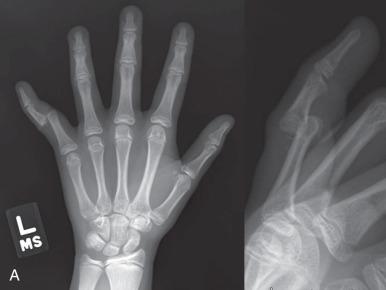
Painless full ROM with a stable joint is the goal. This is achieved with brief periods of immobilization to allow soft tissue healing followed by mobilization to prevent contracture. Unstable joints must be stabilized prior to allowing ROM.
Dorsal or lateral dislocations are generally able to be close reduced. Volar dislocation may have soft tissue interposition or a rotatory component with the lateral condyle buttonholed between the collateral ligament and lateral band. MCP and PIP flexion may allow the digit to be rotated back into place; otherwise open reduction is indicated. Postreduction, the digit should be examined for stability, rigidly immobilized, and radiographed.
Most soft tissue injuries and small bony avulsions can be mobilized early and buddy strapped. Sports can be continued with protection, though use of the rigid splint may compromise glove fit and grip strength. In rare cases, primary repair of soft tissues such as collateral ligaments is indicated if interposed into the joint and requiring open removal, though stiffness is common following this repair.
The exception to early motion is acute central slip injury, which is treated with 6 weeks of full time extension splinting of the PIP joint followed by nighttime splinting for an additional 6 weeks to prevent late boutonnière deformity. DIP motion is encouraged while splinting to draw lateral bands into the dorsal position. Open injuries and large dorsal fractures are operative.
Acute nonoperative management is as above. Patients that present subacutely with proximal interphalangeal (PIP) stiffness undergo static progressive splinting. To achieve extension, the splint includes a point of counterforce on the palmar aspect of the metacarpal head to prevent MCP joint hyperextension while working on PIP motion.
An associated fracture of the middle phalanx involving more than 30% of the articular surface with associated PIP instability is an indication for operative stabilization. Similar to adults, percutaneous pinning, dynamic traction, or internal fixation with mini-fragment screws can be employed. Hemi hamate arthroplasty for volar fractures and suture anchor repair of central slip dorsal avulsion are also considered.
Motion exercises are started 2 weeks postoperatively for most injuries, or until percutaneous pins are removed. Early return to play (RTP) with the PIP joint protected in a rigid cast can be considered for certain sports; however, if PIP extension will hinder function or splinting is not allowed, the athlete will be restricted for a minimum of 6 weeks.
Children with PIP hyperextension injuries have better outcomes than adults. An RCT showed buddy strapping for a week to produce better resolution of edema and pain compared with a group treated with a week of Alumafoam extension blocking orthosis. Full motion was regained in 65% at 1 week and 91% at 2 weeks.
Collateral ligament injuries of the PIP joint treated with buddy taping for an average of 3 weeks demonstrate 77% recovery of grip strength and 84% recovery of ROM at 6 months. Increased disability is associated with delayed treatment, female gender, and radial digit injury at 3 months.
Become a Clinical Tree membership for Full access and enjoy Unlimited articles
If you are a member. Log in here